How to Insulate a Tent for Winter Camping
Winter camping brings some of the quietest, most stunning outdoor moments you’ll ever get, if you can stay warm. I found this out the hard way, shivering all night in a tent that was never meant for snow.
The cold ground felt like it was stealing every last bit of warmth from me. That night, I realized regular summer gear just won’t cut it once the mercury drops.
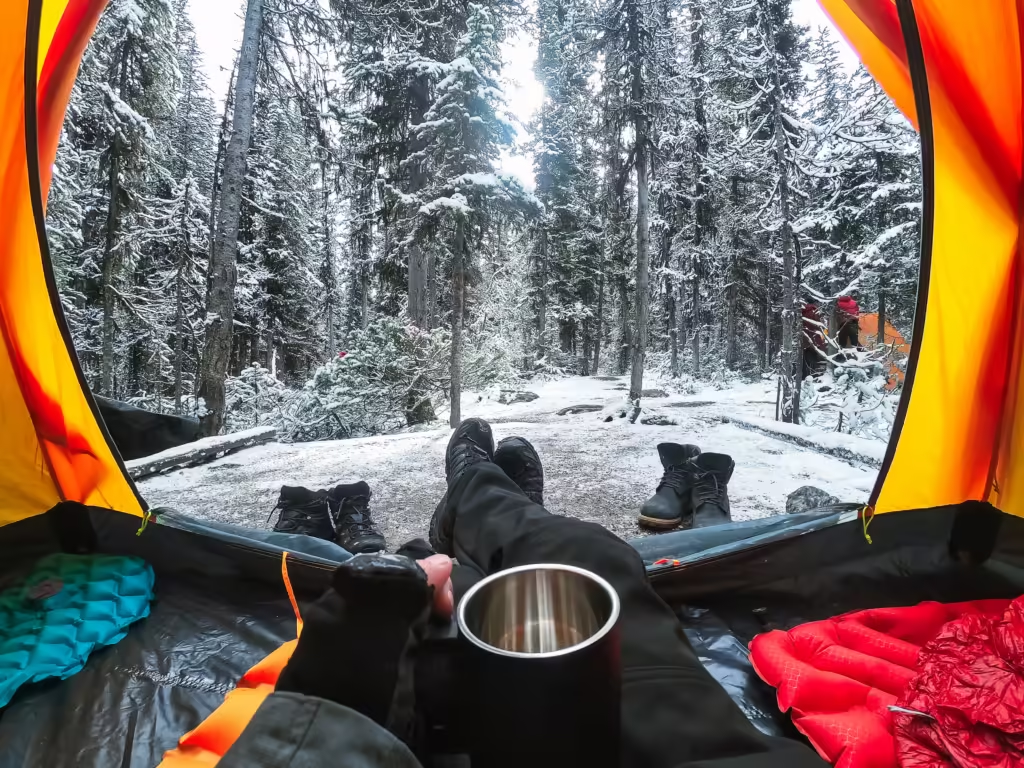
The secret to winter tent camping is layering insulation – think ground barriers, wall tweaks, and smart heat tricks. I’ve learned that good insulation stops heat loss and keeps dampness at bay, so you can actually enjoy the night instead of counting down to sunrise.
What felt impossible at first is now one of my favorite ways to see winter’s peaceful side. I’ll walk you through practical steps – from picking the right tent size, to layering the floor, to managing airflow – that have turned my own winter trips from survival missions into genuinely cozy getaways.
It doesn’t matter if you’re car camping in mild cold or braving deeper wilderness, these tips help you stay safe and comfortable. And honestly, isn’t that what we’re all after?
Key Takeaways
- Pick a smaller four-season tent and insulate the ground first – this is your warm-up foundation.
- Layer up: sleeping pads, thermal blankets, and windbreaks all work together to keep heat in and cold out.
- Choose smart gear – sleeping bags, thermal clothes, and safe heat sources can mean the difference between a long, cold night and a surprisingly comfy one.
Why Tent Insulation Matters in Winter
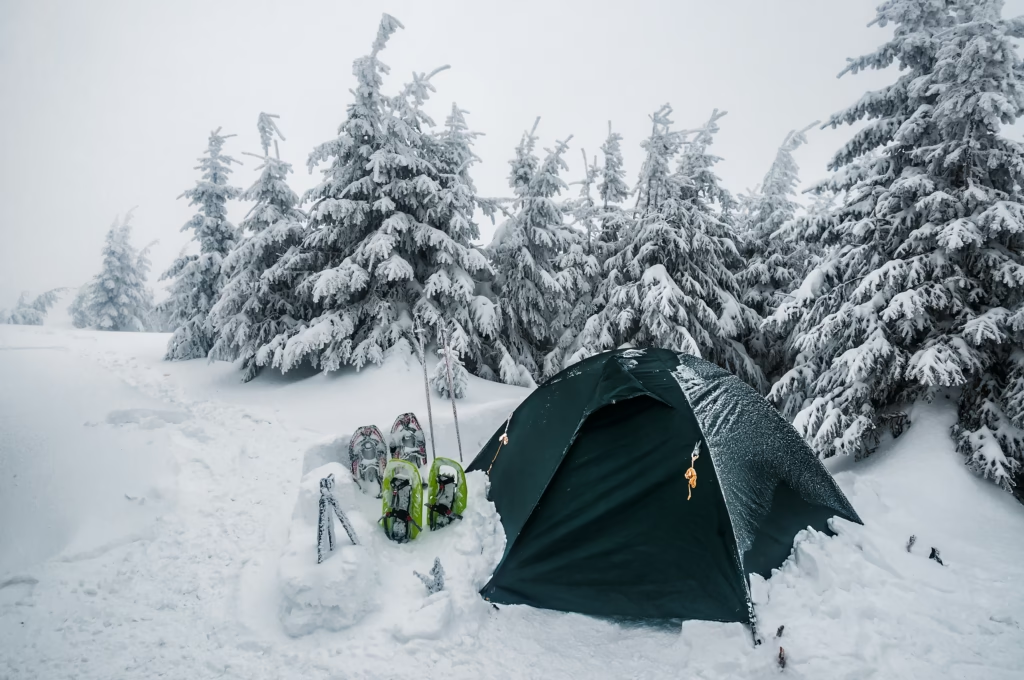
When I started winter camping, I learned quickly: cold air doesn’t play fair. It’ll rob your body heat faster than you expect.
Insulation is your shield. It traps warmth inside and keeps moisture from making things worse.
Understanding Heat Loss in Cold Conditions
Even with a solid sleeping bag, I’d wake up shivering. Turns out, heat escapes in more ways than most people realize.
Conduction is sneaky – it’s how your body heat seeps into the cold ground. The tent floor acts like a giant heat thief.
Convection happens when cold air sneaks in and pushes the warm air out. Every tiny gap or loose spot is a welcome mat for drafts.
Radiation means you’re always losing heat to cold surfaces, even when you’re sleeping. No rest for the warm, right?
I’ve noticed convection is the worst culprit in winter tents. Cold finds every little opening, turning your shelter into a walk-in freezer.
Benefits of Insulating a Tent for Winter Camping
The difference is huge. My insulated tent once stayed 20 degrees warmer than the air outside—felt like magic.
Temperature regulation lets you build a comfy microclimate, so you’re not at the mercy of the elements.
Moisture control is key. Insulation keeps condensation in check, so you don’t wake up in a soggy mess.
Energy conservation means your body gets to relax. You’ll sleep deeper and wake up ready for anything.
Extended camping season opens up when you know how to stay warm. I’ve camped deep into December thanks to a few insulation tricks.
Choosing the Right Tent for Winter Adventures
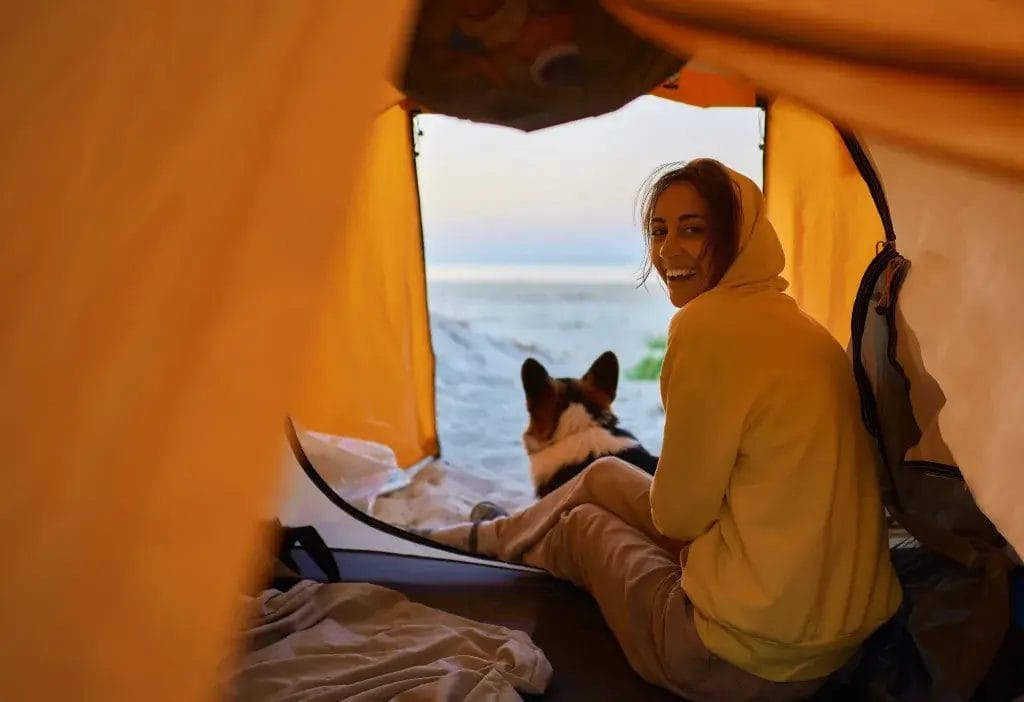
Your tent choice is everything. The right four-season tent can turn a freezing night into a surprisingly cozy one.
Best Types of Tents for Insulation
I learned the hard way: my three-season tent just wasn’t up for winter. Cold air poured in through the mesh, and I barely slept.
Four-season tents are a game-changer. They use solid fabric walls instead of mesh, locking in warmth and keeping wind out.
Summer tents focus on breathability, but four-season tents put insulation first. Less mesh, more warmth, it’s that simple.
Go small if you can. The less space you have to heat, the faster your tent gets warm. I always pick the smallest tent that still fits my group.
Double-wall tents are even better. The air gap between layers adds a bit of extra insulation, which you’ll definitely appreciate.
Extra Features for Cold Weather Tents
I love having a vestibule for cooking and gear storage. It keeps moisture and clutter out of my sleeping area, which makes a difference on stormy nights.
Reinforced guy-out points matter. Winter winds and heavy snow can wreck a tent that isn’t built tough. I’ve seen it happen, and it’s not pretty.
Color-coded poles are a lifesaver when you’re fumbling with gloves on. Setting up in the cold is hard enough, don’t make it harder.
Steep tent walls shed snow better than domes. Snow piles up fast and adds weight, so I go for pyramid or A-frame tents when I expect heavy snow.
Internal pockets and gear loops keep your essentials handy. Trust me, you don’t want to dig for your headlamp when you’re bundled up like a marshmallow.
Insulating the Tent Floor and Ground
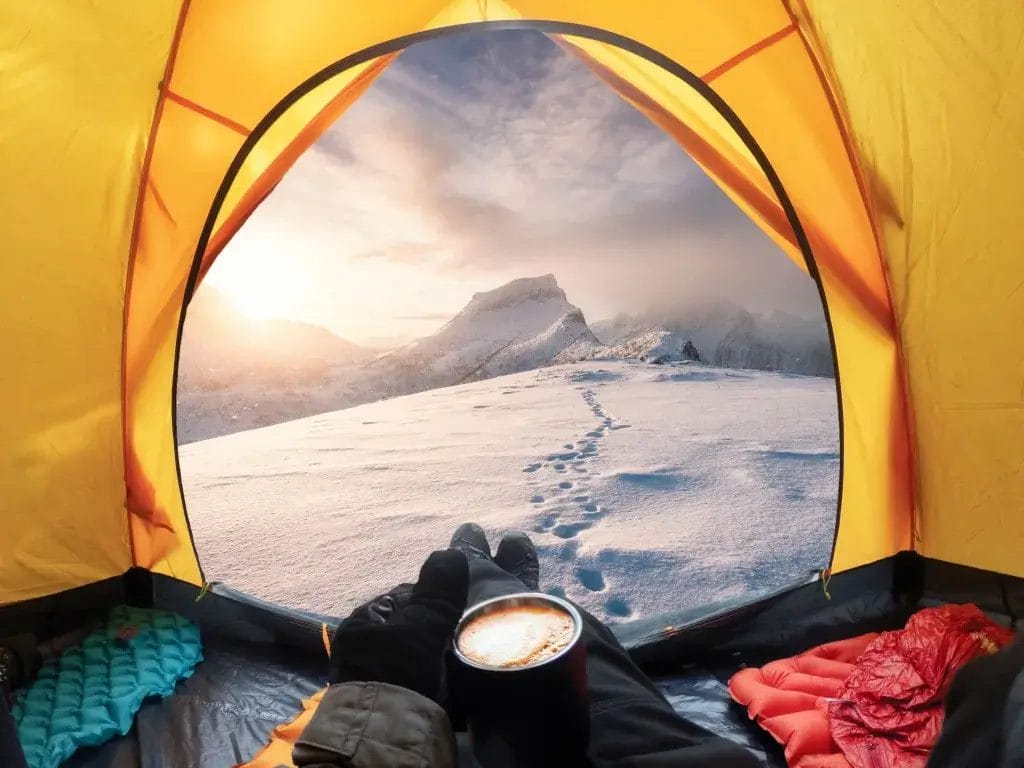
Good ground insulation is your first line of defense. I’ve found that layering, using tarps, foam, even old rugs, makes a world of difference.
Using Tarps and Ground Covers
I always start with a sturdy tarp under my tent. It blocks moisture and keeps the cold ground from zapping my heat.
I let the tarp extend just past the tent, then tuck the edges under to keep rain or snow from pooling. Simple, but it works.
Inside the tent, I add another layer. Emergency blankets are clutch; their reflective side bounces heat right back at you.
They’re light, packable, and perfect for backpacking. Just remember to put the shiny side up. I learned that the hard way on a frosty October night.
Layering with Foam Pads and Rugs
Closed-cell foam pads are my not-so-secret weapon. They keep insulating even when it’s freezing, unlike air mattresses that can get chilly.
I use two layers: a closed-cell foam pad (at least ½ inch thick) on the bottom, then an insulated sleeping pad on top for comfort.
- Bottom layer: Closed-cell foam pad (½ inch or thicker)
- Top layer: Insulated sleeping pad
This combo keeps the cold at bay and gives a little cushion for sleep. I’ve tried thinner pads, but thicker ones (¾ inch) are even better if you can fit them in your pack.
Old rugs or carpet scraps work too. I once tossed in a bathroom rug from home and it made my tent feel almost luxurious.
Natural Ground Insulation Tips
If there’s snow, I pack it down before pitching my tent. Packed snow insulates better than loose, fluffy stuff and gives you a solid base.
Pine needles or dry leaves are great if you find them. I pile them up about 6 inches deep before setting my tarp down.
They trap air and add a buffer, but make sure they’re dry. Wet leaves are a recipe for a cold, damp night.
Pick your campsite carefully. I look for spots sheltered from wind and avoid dips where cold air settles.
Rocky or sandy ground doesn’t hold cold as much as dirt or clay. A little scouting pays off in warmth later.
Enhancing Tent Walls and Roof for Maximum Warmth
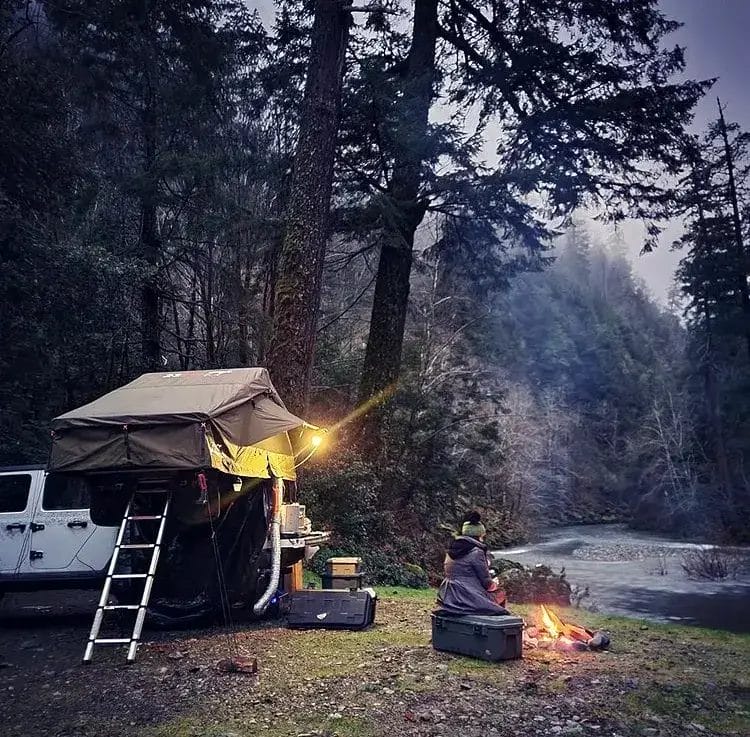
The tent walls and roof are where heat escapes fastest. I focus on these with reflective blankets, extra layers, and smart venting to turn even a basic three-season tent into a cozy winter hideout.
Reflective and Thermal Blankets
I picked up this trick during my first freezing night in the mountains. My sleeping bag just wasn’t enough, and I needed a solution fast.
Emergency blankets work surprisingly well when you stick them onto your tent walls. They bounce your body heat right back at you instead of letting it drift away into the night.
The real secret? Spray adhesive and plastic sheets on the outside walls first. This combo creates a vapor barrier that keeps the warm air from sneaking out.
After that, I attach the shiny emergency blankets to the inside walls. I usually use gentle tape or a removable adhesive, just in case I want to take them down later.
Here’s my go-to setup:
- Large plastic sheets on exterior walls
- Reflective emergency blankets on interior surfaces
- Extra coverage over the roof, since heat loves to rise
Face the reflective side in toward your sleeping area. In my experience, covering about 70% of the wall space strikes the best balance – plenty warm, but not claustrophobic.
One quick heads-up: skip this method if you already have a four-season tent with solid insulation. Otherwise, you’ll probably wake up in a puddle of sweat. Not fun.
Adding Extra Tarps and Rain Flies
Throwing a second layer over your tent creates what I like to call the “double wall effect.” It traps a pocket of air between layers and gives you bonus insulation against wind and rain.
Using a tarp over your tent adds another barrier and helps block out cold gusts. I usually set my tarp about six inches above the tent roof, close enough to trap warmth, but not so close that it squashes the air space.
My favorite tarp setups:
- A-frame style: Covers the whole tent with sloped sides
- Lean-to setup: Shields you from the wind
- Full wrap: Gives max protection, but you’ll need more guy lines
Pull your rain fly tight so it doesn’t flap around all night. I add extra guy lines to nearby trees or hammer in more stakes if the wind’s really moving.
For extra ground-level protection, I run the tarp edges down the tent sides about a foot. This blocks those sneaky drafts that like to creep in under your floor.
Sealing Drafts and Reducing Condensation
Tracking down and sealing air leaks made a huge difference in how warm my tent stays. Even tiny gaps around zippers, stake points, and seams can let in a ton of chilly air.
I use lightweight duct tape for obvious gaps. But the real trick is feeling around the tent perimeter on a windy day, your hand will find every spot where cold air sneaks in.
Common draft locations to check:
- Zipper tracks and pulls
- Stake attachment points
- Seam intersections
- Closed ventilation flaps
Ventilation is still crucial to prevent condensation. I learned the hard way, woke up once to a sleeping bag covered in ice crystals. Not my best morning.
Keep at least one small vent cracked open, even when it’s cold. It’s all about controlling airflow, not shutting it down completely. Aim your vent away from the wind so you don’t lose heat, but moisture can still escape.
I keep a small towel near the tent door to wipe off condensation before it freezes. It takes just a minute and keeps your tent fabric from getting crusty with ice over time
Smart Sleeping Setups Inside Your Tent

Your sleeping setup is the real game-changer between a miserable, teeth-chattering night and waking up feeling like a happy burrito. The right mix of sleeping bag, liner, and pad can create a cozy cocoon, even when the temps dip way below freezing.
Choosing the Right Sleeping Bag and Liner
I always pick a warm sleeping bag rated at least 10-15 degrees colder than what I expect. I go by the comfort rating, not the survival one. Trust me, there’s a difference.
Temperature Rating Guidelines:
- 20°F to 32°F: 15°F rated bag minimum
- 0°F to 20°F: 0°F rated bag minimum
- Below 0°F: -10°F or colder rated bag
Down fill is super warm and light, but it loses its magic if it gets wet. Synthetic fill is cheaper and keeps you warm even if it’s damp.
A sleeping bag liner adds 5-15 degrees and keeps your bag cleaner. I use a silk liner for lightweight warmth or fleece if I want to really bundle up.
Mummy bags trap heat better than rectangles. Make sure your bag fits, too tight and you can’t move, too loose and you’ll get cold spots.
Layering Sleeping Pads and Rugs
The ground will suck the heat right out of you. I always stack a couple of layers under me for serious insulation.
An insulated sleeping pad with an R-value of 4 or higher is my go-to base. R-values measure insulation; the higher, the toastier.
R-Value Requirements:
- Summer: R-1 to R-2
- Three-season: R-2 to R-4
- Winter: R-4 to R-6+
- Extreme cold: R-6+
I put a closed-cell foam pad under my inflatable pad. That way, I get extra insulation and a backup if my main pad pops in the middle of the night.
Foam pads are cheap and never fail. They’re bulky, but if you want to stay warm, they’re worth the hassle.
Budget tip: Old carpet scraps or yoga mats work in a pinch. I’ve even piled up pine needles and dry leaves under my tent for extra insulation.
Sleeping Tricks for Retaining Body Heat
Little tricks go a long way to keep you warm all night. Here are a few I’ve picked up over the years.
Pre-heat your sleeping bag by tossing in a hot water bottle about 30 minutes before bed. It feels amazing to climb into a warm bag.
Always sleep in dry base layers, not the clothes you sweated in all day. Damp clothes will chill you fast.
Stash tomorrow’s clothes inside your sleeping bag. That way, you wake up to toasty gear instead of stiff, frozen fabric.
A warm hat is a must. I lose a ton of heat through my head, so I always wear a beanie to bed.
Try not to breathe inside your sleeping bag. The moisture from your breath will make things damp and chilly by morning.
Eat a small snack before bed. Your body needs fuel to make heat while you sleep.
Do a quick round of jumping jacks or push-ups before you crawl in. Warming up your blood first helps you stay cozy longer.
Managing Heat and Reducing Cold Air Entry

Keeping your tent safe from wind and sneaky cold air is the difference between a miserable night and a cozy winter adventure. With some smart placement and a few simple barriers, you can boost your tent’s warmth by a surprising amount.
Strategic Use of Windbreaks and Snow Walls
I always look for natural shelter before setting up camp. Dense tree lines, big boulders, or even a hillside can block chilly gusts.
- Dense tree lines
- Large boulders or rock formations
- Hillsides that block prevailing winds
If I can’t find a natural windbreak, I build my own snow wall. It sounds like a hassle, but 30 minutes of digging saves hours of shivering. I pile snow about three feet high on the windward side of my tent.
Snow works as insulation, too. An old-timer once showed me how packed snow traps air pockets and helps block the cold.
For a quick fix, I carry a lightweight tarp to use as a windbreak. I string it between trees or prop it up with trekking poles. The trick is to angle it so the wind gets deflected up and over your tent, not around the sides.
Setting Up Your Tent for Optimal Protection
My tent placement strategy has changed a lot over the years. Now I follow my “wind direction rule” – always pitch the tent’s narrow end into the wind.
Site selection is sometimes more important than gear. I steer clear of:
- Valley bottoms where cold air pools
- Ridge tops blasted by wind
- Open spots with no natural protection
I hunt for places that are sheltered but not so low that moisture gathers.
If there’s snow, I dig my tent platform in just a bit. That creates a natural windbreak and helps regulate temperature. I use the snow I dig out to build up perimeter walls.
Door placement matters too. I always face the tent door away from the wind. On wild nights, I build a mini vestibule with extra snow walls; it’s a buffer that keeps cold air from blasting in when I go in or out.
The tent footprint needs attention in winter. I clear the area, then stomp down the snow to make a solid, level base that won’t shift overnight.
Advanced Techniques for Extra Warmth

If the basics aren’t cutting it, these advanced tricks can turn a brutal night into cozy comfort. Try layering smart, using safe heat sources, and thinking creatively. Your winter camping game will never be the same.
Safe Use of Tent Heaters
Tent heaters always make me a little uneasy, and honestly, that’s not a bad thing. Used the right way, though, they can turn a miserable night into a warm oasis, especially when the mercury plummets.
Never use propane or gas heaters inside a regular tent. Carbon monoxide is no joke; it’ll sneak up on you, and I’ve seen too many near-misses from folks who thought they’d be fine.
Your safest move is a hot tent with a wood-burning stove. These setups come with built-in vents and fire-resistant materials, so you can breathe a little easier.
If you really need a tent heater, stick with electric models made for tents. Battery-powered ceramic heaters are my go-to – they’re quiet, effective, and won’t fill your tent with nasty gases.
Essential safety rules:
- Always maintain proper ventilation
- Keep heaters away from tent walls
- Never leave heaters running while sleeping
- Bring a carbon monoxide detector
One February in Colorado, my friend brought a cheap propane heater. Within an hour, our tent filled with fumes, and we both woke up with pounding headaches. We were lucky, and that scare still sticks with me.
Wearing Thermal Layers and Accessories
Layering saved my skin during polar training, and it’ll do the same for you. Your body is your best heat source, just trap that warmth and you’re golden.
Start with a merino wool base layer right against your skin. Synthetics work too, but wool stays warm even when it gets damp. I’ve rocked the same wool base for three days and, surprisingly, it didn’t smell too bad.
Throw on a fleece or down layer for insulation. Top it off with a wind-blocking shell if you’re feeling chilly inside your bag.
Don’t forget these crucial accessories:
- Wool socks (always pack extras)
- Insulated hat or balaclava
- Light gloves for those late-night bathroom runs
- Neck gaiter or buff
The balaclava was a game-changer for me. I used to wake up shivering with my head sticking out, but now I pull a thin balaclava down over my eyes and sleep like a log. Sure, I look ridiculous, but who cares when you’re warm?
Your feet will lose heat fast. Dry wool socks are a must, and foot warmers can make a huge difference. I always keep a fresh pair of socks just for sleeping – trust me, it’s worth it.
Using Hot Water Bottles for Nighttime Comfort
I swear by hot water bottles for winter camping. They’re simple, reliable, and make a massive difference on freezing nights. I never head out without at least two.
Just fill a strong Nalgene bottle with hot water before bed. These bottles are tough, and the wide mouths make them easy to fill. Wrap one in a sock or towel to avoid burning yourself.
Stick a bottle at your feet and another near your core. The heat spreads through your sleeping bag and can last for hours. On truly frigid nights, I’ll fill three bottles and swap them around as they cool.
Pro tips for hot water bottles:
- Use water just below boiling (about 180°F)
- Fill bottles all the way up for max heat
- Test the temp before putting it against your skin
- Refill if you wake up cold in the night
One January in Montana, it hit -15°F. My hot water bottles kept me comfy all night while my tentmate froze in his fancy bag. He asked for a bottle the next night – lesson learned.
Bring a solid way to heat water. A small stove and a lightweight pot work great. Hot water bottles stay warm for hours and give you steady, safe heat till morning.
Frequently Asked Questions
Every time I bring up winter camping, the questions start rolling in. Most folks want to know what materials work best for tent insulation and if their summer gear can survive a cold snap.
What are the best materials to use for winter camping tent insulation?
After years of trial and error, I’ve fallen in love with reflective emergency blankets. They’re light, cheap, and bounce heat right back at you.
Closed-cell foam pads are a game-changer for the floor. I always pack at least two, one under my sleeping pad, one as backup.
For the walls, space blankets or mylar sheets are my favorites. They’re easy to find and barely take up any space in your pack.
Wool blankets work wonders, too, though they’re heavier. My old army surplus blanket from my grandpa still gives me that cozy cocoon feeling that synthetic stuff can’t match.
Can you give some tips on DIY insulation for keeping a tent warm in the cold?
My go-to DIY move? Duct tape and emergency blankets. I tape the shiny side to my tent walls to keep the warmth inside.
Pine needles and dry leaves make surprisingly good ground insulation. I gather them up before pitching my tent and make a thick layer under the footprint.
Hot rocks wrapped in towels can radiate heat for hours. I heat them by the fire, wrap them up, and set them inside the tent—just be careful not to burn anything.
Old carpet scraps work great for the floor. I found some headed for the dumpster, cut them to size, and they’ve kept my feet warm for years.
What should I look for when purchasing a tent insulation liner or kit?
Pick liners with a reflective surface facing inward. The shinier, the better, it’ll bounce your body heat right back at you.
If you’re backpacking, watch out for heavy liners. I learned that the hard way on a long winter hike, my back still remembers.
Make sure the liner fits your tent. Universal sizes exist, but a custom-fit liner is easier to set up and keeps the warmth in better.
Check how the liner attaches. Velcro is fine, but I like snap systems—they hold up better when it’s freezing out.
How can I effectively insulate the walls and floor of my tent for a snowy adventure?
For walls, I use reflective insulation and clip it up with binder clips. This creates a little air gap that makes a big difference.
Never skimp on ground insulation. Snow will suck the heat right out of you. I go with a tent footprint, closed-cell foam, and my usual sleeping pad.
Building a snow wall around your tent helps block wind and traps warmth. I pile snow waist-high on three sides, leaving the door clear so I don’t trip in the night.
Inside, I toss down rugs or carpet scraps. Not only does it insulate, but it feels like heaven on bare feet during those chilly midnight walks.
Is there a way to make my summer tent suitable for winter conditions with additional insulation?
It’s possible, but be careful. Summer tents can’t handle heavy snow, so avoid deep-winter storms.
I’ve winter-camped in my summer tent by lining the inside with emergency blankets. For milder cold, it works surprisingly well.
Add extra guy lines and stakes meant for frozen ground. Standard tent stakes won’t cut it in hard snow or ice.
Watch out for too much ventilation. Summer tents can get drafty, and you might lose more heat than you expect.
What are some creative insulation hacks for campers looking to upgrade their winter tent setup?
Battery-powered heated insoles inside your sleeping bag can create a little warm zone around your feet. I stumbled on this trick during a February camping trip that felt like a test of human endurance.
Bubble wrap works surprisingly well as window insulation if your tent has clear panels. Those little air pockets trap heat but still let in some natural light, so you won’t feel like you’re hibernating in a cave.
Hand warmers tucked in strategic spots can make a big difference. I like to tape them to the tent ceiling above my sleeping area; they radiate heat downward all night and keep the chill at bay.
A small candle lantern can pull double duty, giving you both light and a bit of heat. Pop it into a safe metal container, and you’ll have a tent that feels way cozier (plus, the flickering glow is pretty charming on a cold night).








